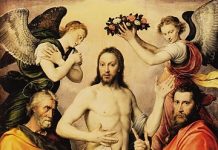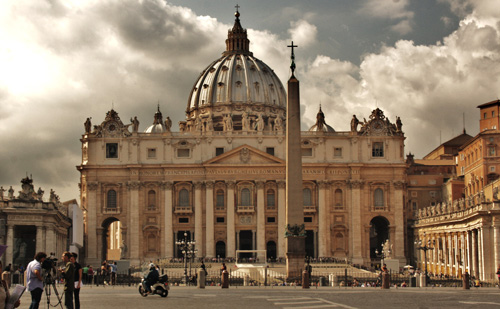On Saturday, July 22nd, the Church universally celebrated the feast of St Mary Magdalene. Personally speaking, this great woman is of great inspiration for me of what it means to be an apostle of Jesus.
It was the Angelic Doctor, St Thomas Aquinas, who named her as “Apostle of the Apostles”, for the reason that she announced to the apostles of Jesus the greatest news that could ever be announced, namely that Jesus was risen from the dead. The Johannine Gospel says its so clear in the famous story we read in her feast day:
Now on the first day of the week Mary Magdalene came to the tomb early, while it was still dark, and saw that the stone had been taken away from the tomb. So she ran, and went to Simon Peter and the other disciple, the one whom Jesus loved, and said to them, “They have taken the Lord out of the tomb, and we do not know where they have laid him.”
But Mary stood weeping outside the tomb, and as she wept she stooped to look into the tomb; and she saw two angels in white, sitting where the body of Jesus had lain, one at the head and one at the feet. They said to her, “Woman, why are you weeping?” She said to them, “Because they have taken away my Lord, and I do not know where they have laid him.”[Saying this, she turned round and saw Jesus standing, but she did not know that it was Jesus.
Jesus said to her, “Woman, why are you weeping? Whom do you seek?” Supposing him to be the gardener, she said to him, “Sir, if you have carried him away, tell me where you have laid him, and I will take him away.” Jesus said to her, “Mary.” She turned and said to him in Hebrew, “Rabboni!” (which means Teacher). Jesus said to her, “Do not hold me, for I have not yet ascended to the Father; but go to my brethren and say to them, I am ascending to my Father and your Father, to my God and your God.” Mary Magdalene went and said to the disciples, “I have seen the Lord”; and she told them that he had said these things to her (John 20:1-2. 11-18).
Historically her name is a derivative from Magdala, her hometown. This town was a fishing village which is located on the western shore of Lake Tiberias. It is the evangelist Luke who, in his eight chapter of his Gospel, narrates to us that as Jesus was preaching the Good News of the Kingdom of God, accompanied by the Twelve apostles, he also had with him some women whom he healed from evil spirits our infirmities. Then the third evangelist tells us: Mary, called Magdalene, from whom seven demons had gone out (Lk 8:2). The biblical expression ‘seven demons’ seems to allude to a serious physical or moral malady which tormented Mary and Jesus lovingly had freed her from.
Mary Magdalene has nothing to do with the woman who bathed Jesus’ feet with perfume as well as with her tears and dried them with her hair. This misunderstanding, according to Cardinal Gianfranco Ravasi, comes from referring to Mary Magdalene the anointing with perfumed oil which Mary, the sister of Martha and Lazarus, did. Mary Magdalene and Mary of Bethany are not the same. Neither is she the prostitute of Galilee. (Editor’s note: This is the currently accepted premise, although some of the Fathers, Saint Gregory not least, disagree with this thesis).
Mary Magdalene is truly the “apostle of the apostles” because of her faithfulness to the Lord Jesus. She is there, with Jesus, at the most dramatic moment of his life, namely at the foot of the Cross. She is accompanying him as he was dying at the Calvary, together with other women, from a distance. Mary Magdalene remained there when Joseph of Arimathea took Jesus’ body and placed him in the new sepulcher, which was closed with a stone. She kept following Jesus by going to his tomb, finds the stone rolled away and swiftly goes to Peter and John to warn them. These two disciples, hurriedly, go to the empty tomb to see that the body of Jesus is not there.
Then the evangelist John, as we have said earlier, magnificently recounts her meeting with the Risen Lord. Now Mary has a very powerful mission from Jesus. After he called her by name and she replied to him Rabboni (teacher) (John 20:16), the grace of the resurrection penetrated her throughout and readied her for this mission the Risen Jesus had in store for her: Do not hold me, for I have not yet ascended to the Father; but go to my brethren and say to them, I am ascending to my Father and your Father, to my God and your God (John 20:17).
Mary Magdalene’s place is so unique because she is the first one to announce Jesus’ Resurrection from the death. She was the one who powerfully announced the joyousness of the Easter message. Furthermore, she was faithful to Jesus when the other apostles, except John, deserted him. Mary Magdalene remained standing with Mary, Jesus’ Mother and the disciple John. She was determined to say with the One she loved till the very end.
Her direct encounter with the Risen Jesus was the turning point of her life. In his general audience of Wednesday, 17 May 2017, Pope Francis teaches us: And Jesus calls her: “Mary!”: the revolution of her life, the revolution destined to transform the life of every man and every woman begins with a name which echoes in the garden of the empty sepulchre. The Gospels describe Mary’s happiness. Jesus’ Resurrection is not a joy which is measured with a dropper, but a waterfall that cascades over life. Christian life is not woven of soft joys, but of waves which engulf everything. You too, try to imagine, right now, with the baggage of disappointments and failures that each of us carries in our heart, that there is a God close to us who calls us by name and says to us: ‘Rise, stop weeping, for I have come to free you!”. This is beautiful...
And so that woman, who, before encountering Jesus, had been at the mercy of evil (cf. Lk 8:2) now becomes the Apostle of the new and greatest hope. May her intercession also help us live this experience: in times of woe and in times of abandonment, to listen to the Risen Jesus who calls us by name and, with a heart full of joy, to go forth and proclaim: “I have seen the Lord!” (v. 18). I have changed my life because I have seen the Lord! I am now different than before. I am another person. I have changed because I have seen the Lord. This is our strength and this is our hope.
May we too encounter the Lord! May we too let him call us by name! May we too, filled with the same joy of Mary Magdalene, go out and proclaim with that extreme joy that Christ has Risen and is Risen indeed, first and foremost in our lives and that his saving presence is amongst us to transform us from within!
How beautiful and life-giving it is to be an apostle of the Risen Jesus in today’s world full of doom and gloom. Mary Magdalene is encouraging us to be like her, totally open and cooperative to Jesus’ transforming initiative. This is the lesson St Mary Magdalene teaches me on her feast day.











